by Matt Corrion
While visiting a project site last week I noticed a mistake in landscape design that I had to share:
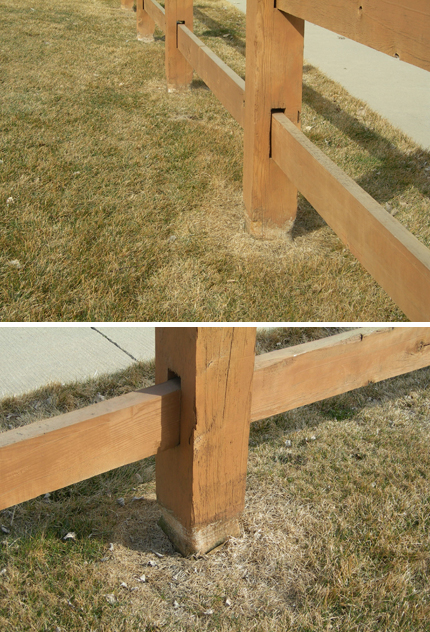
In our landscape plans we always prefer to place fencing out of lawn areas and within landscape beds, or at least in a strip of rock. In the photos above, these nice 6″x6″ posts are being slowly whittled away by trimmers, commonly known as “weed wackers”.
This is a condo project that was only built about 10 years ago. I don’t blame the maintenance crews, I blame a poor landscape design.
If anything, the maintenance crews are probably cursing the landscape architect- because they have to trim around about 80 of these posts every week.
Since lawn was designed around the fence (rather than placing the fence in a strip of rock), it also gets over-sprayed by the lawn irrigation, which not only wastes water, but will quickly deteriorate a wood fence. That’s probably why it looks like it recently had to be re-stained.
This is the official blog of Outdoor Design Group, Colorado Landscape Architects. For more information about our business and our services, click here.
Related Posts:
by Todd Rutherford
Who doesn’t love seeing the golden glow of aspen leaves (Populus tremuloides) dancing in the breeze on a mountain hillside? Many gardeners living at Colorado’s lower elevations have been smitten by the quaking leaves of aspen trees and tried to bring some of that mountain magic into their own yard. But doing so reveals lessons in plant ecology, and reminds us that not every plant we want to have in our home landscapes can easily grow there.
Aspens are a “succession” tree, moving into areas where other trees and shrubs were removed by logging, fire, erosion, insects or disease. As a succession species, they are not long lived. Their presence helps lead the way to other longer living trees.
In addition, aspens are highly susceptible to insect damages and diseases. Aspens that were collected in the wild are even more prone to damage and disease, as their root system is either injured or is incomplete during collection. Nursery grown aspens are generally healthier than collected ones, but still will likely succumb to problems and a shortened life.
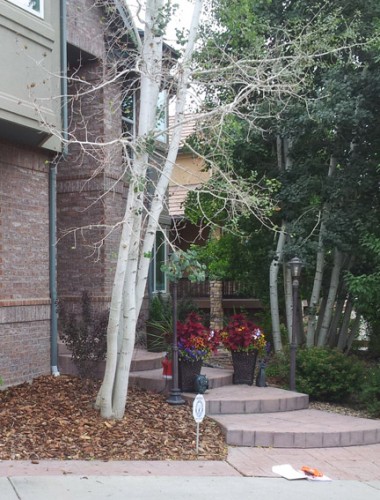
A diseased aspen tree.
Most arborists and horticulturists advise against planting Aspens along the Colorado’s Front Range. The growing conditions of the Front Range are different than those areas where Aspen thrive naturally. Aspens like to grow in gravelly, moist but well-drained soil with a lower pH (more acidic) that can typically be found at higher elevations. Along Colorado’s Front Range, our soils are typically heavy clay soils that don’t drain well and have a higher pH (more alkaline). Summer weather along the Front Range is hotter and drier than in the mountains, another factor going against the health of Aspens planted east of the high country.
If you really must have the quaking leaves of aspen in your yard, only plant them if you can place them in the north or east sides of your home (due to the afternoon heat of south and west exposures) and only if it is a nursery grown tree. Keep them away from objects that might radiate too much heat to the trees such as paving. Amend the soil with organic matter in an attempt to increase the acidity of the soil, and then mulch the newly planted tree well. You might also consider adding gravel or perlite to the soil before you plant to improve drainage, and reduce the problem of heavy clay soil.
Even if you can adhere to the aforementioned criteria while planting your aspen, it’s not likely your tree will achieve the brilliant gold of the aspens at higher elevations due to differences in soil chemistry, soil texture, soil moisture, day and night temperatures, and sunlight discrepancies at the different elevations. In addition you should be on the lookout for several different diseases and insects that more readily afflict aspens planted out of their native range.
Furthermore, if you want to remove aspen trees that are established in your yard, you may get many suckers (the stems that sprout up from aspen roots) coming up in your yard for many months after you removed the main trunk.
So in my opinion, no, aspen trees should not be planted in the Denver area, because it is not likely they will do well. But if you are aware of the many shortcomings of aspens planted outside of their native range, feel free to give them a try.
This is the official blog of Outdoor Design Group, Colorado Landscape Architects. For more information about our business and our services, click here.
Related Posts:
by Todd Rutherford
As gardeners in Colorado may well know, our climate and altitude make for challenging growing conditions. This doesn’t mean we are completely immune from invasive exotic plants making an unwelcome home here. We do not have the burden that gardeners in wetter and warmer states may have at stopping the spread of invasive plants, but there are a few species you should be aware of so you can help stop these unwanted guests from gaining a foothold in our landscapes.
Why be concerned about invasive plants? They crowd out native plants, propagate uncontrollably, and may reduce forage for wildlife. Some may have a negative impact on your garden plants. And research suggests that some invasive species may pose dangers to humans through the increased risk of flooding due to damaged waterways, or increased fire danger.
The two worst invasive woody plants for Colorado and the surrounding region are the Russian Olive and the Tamarisk. Russian Olive (Elaeagnus angustifolia), is native to western and central Asia. It was introduced into North America in the latter part of the 1800’s. It is not related to true olive plants (Olea europaea) but its fruit is edible but not very palatable for human consumption. It out competes native plants because its seeds are irresistible to birds which spread the seeds far and wide. The seeds have a low mortality rate, germinate readily in poor soil (it can fix its own nitrogen in its roots), reach maturity quickly and thus outcompete native plants. In Colorado, they often begin setting a foothold in riparian areas, and then spread from there.
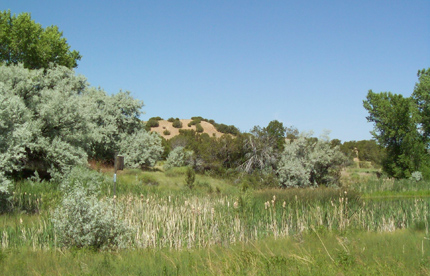
Russian Olives invading a wetland in New Mexico.
Tamarisk (Tamarix ramosissima), which is more of a shrub than a tree, similarly starts its spread in the riparian areas of the Colorado and other southwestern states. It has been such a successful invader of wet areas, that it has overtaken huge sections of the rivers of the southwest. However, it is not as tolerant of cold temperatures as is Russian Olive, which restricts its spread to the warmer, lower elevations of the southwest. Tamarisk is tolerant of many soil types, and thrives in full sun. One of the concerns about Tamarisk’s effect on native landscapes is how they out compete native vegetation, altering the nutrient cycles of riparian areas. They also consume large amounts of water, and secrete large amounts of salt, both items further slowing the success of nearby native plants. A massive amount of resources and manpower are being directed at the fight to stop the spread of this plant through the wildlands of the desert southwest.
…the Siberian Elm is “one of, if not the, world’s worst trees…a poor ornamental that does not deserve to be planted anywhere”.
Closer to Denver and the urban areas of Colorado’s front range, there are two trees that are common pests. These are the Siberian Elm (Ulmus pumila), and the Tree of Heaven (Ailanthus altissima). Both of these trees release a profuse amount of seeds, and these seeds are very adept at sprouting in disturbed areas. They proliferate along transportation corridors and abandoned lots. Both trees prefer full sun, but Ailanthus can tolerate some shade allowing it to invade some mature native forests.
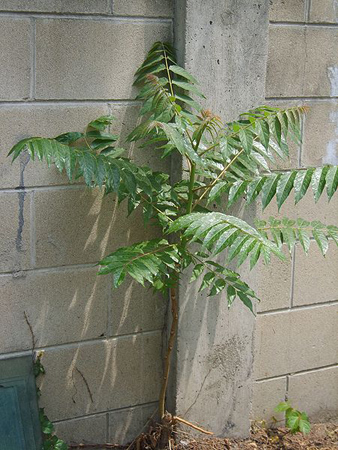
Young Ailanthus altissima
Although not directly related, Ailanthus trees (a.k.a. Tree of Heaven) are often mistaken as sumacs. In springtime they produce many flowers that have a foul odor which some say is similar to cat urine. It rapidly out competes other tree species, releasing an allelopathic chemical which inhibits the growth of other plants. Some researchers have extracted this chemical from Ailanthus trees, successfully using it as an herbicide. Not only is this tree toxic to other plants, there have been anecdotal reports of it being slightly toxic to humans and livestock. Ailanthus trees can grow quite rapidly, leading to weak, unstable branches.
Siberian Elms also have structural problems, with many weak or dead branches that can break off in heavy wind. Siberian elms have a short dormancy period which leads to early flowering in spring, and late leaf drop in fall. In Colorado that means they can become dangerously loaded with wet snow in our common heavy spring snowstorms, or the occasional fall snowstorm, leading to heavy branches falling on roofs and vehicles. In addition to the dangers of breaking limbs, the trees do not have a very favorable appearance, with an awkward branching pattern. One doesn’t need to search too long before you find many Siberian elm seedlings sprouting up in unwanted spots in the urban landscape. The sprouts show up in shrub beds where they are difficult to remove by hand and hard to spray with herbicides without damaging neighboring desired plant materials. Siberian elms are susceptible to damage from elm leaf beetles which leave the leaves looking skeletonized, but it doesn’t seem to kill the trees. Notable horticulturalist Michael Dirr says the Siberian Elm is “one of, if not the, world’s worst trees…a poor ornamental that does not deserve to be planted anywhere”.
To be fair, I should mention that some people look favorably upon these four tree species, and say that in Colorado’s high desert climate (that is naturally and predominantly tree-less east of the Rocky Mountains), an invasive tree is better than no tree, especially in urban areas. I would beg to differ, noting that these trees are too difficult to control and remove, to the detriment of native flora and fauna. Please become aware of these invasive trees and be considerate about whether you want to allow these in your landscape.
This is the official blog of Outdoor Design Group, Colorado Landscape Architects. For more information about our business and our services, click here.
Related Posts:
by Todd Rutherford
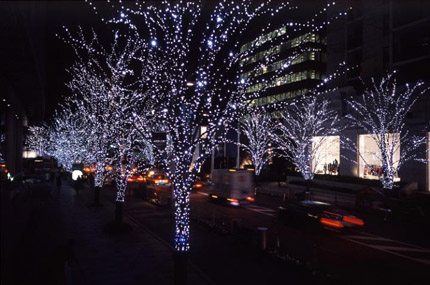
If you’ve not purchased holiday lights in several years, you are in for some surprises next time you head out shopping for new holiday lighting. Recent advances have produced a wave of new and innovative LED lighting that is far more energy efficient than holiday lighting your father or grandfather installed in years past. Many of the new LED holiday light strings are 7 to 8 times more efficient than traditional incandescent light strings. This translates to additional benefits aside from lowered electricity bills: more strings can be safely strung together end-to-end (which may mean a simplified layout of your light display) and there is a lowered fire hazard as the strings do not get as hot as many of the incandescent holiday light bulbs.
One down side to these new types of holiday lights is their higher up-front cost. But if you calculate in the lower operating costs, LED lights are likely to cost you less money in the long run. And as more LED holiday lights are being manufactured, prices have been dropping.
One criticism of LED lights has been the tendency of light from LED bulbs to appear harsh and “cold”. Manufacturers have responded to this issue and are now producing LED holiday lighting that appears “warmer”, like the incandescent lights they are intended to replace.
So this year, consider adding some ‘green’ lights to your holiday decor by choosing energy efficient LED holiday lights.
Here’s a list of pros and cons for LED Holiday lighting:
PROS
Lower energy use / operating cost
Lower heat output (Less fire hazard)
Longer life
More strings can be connected safely (Fewer outlets or extension cords needed)
CONS
Higher purchase cost than incandescent.
Color & “temperature” of light output difference as compared to incandescent
This is the official blog of Outdoor Design Group, Colorado Landscape Architects. For more information about our business and our services, click here.
Related Posts:
by Todd Rutherford
I wanted to revisit Matt’s post on the 20 Best Xeriscape Plants for Colorado, and add to his list of great low-water plants for Colorado landscapes. As with Matt’s initial posting, this list of plants also offers a great variety of color, texture and form for your water-wise garden. Consider adopting some of these amazing plants into your landscape, and tell all your friends about the benefits and beauty of drought tolerant plants.
Perennials:
- Chocolate Flower – Berlandiera lyrata An intoxicating chocolate scent emanates from the yellow blooms of this low water southwestern wildflower from summer into fall.
- Whirling butterflies – Gaura lindheimeri Whirling Butterflies truly lives up to its name. Growing 2-3’ tall by 18-24” wide, this perennial has a significant bloom time, sporting multiple flower stalks that whirl numerous small white flowers in the late summer breezes.
- Creeping Veronica – Veronica spp. A spring blooming favorite, creeping veronicas are somewhat adaptable to light and moisture conditions. The deep green foliage is often evergreen in winter and makes a nice backdrop to the abundant light blue to purple flowers that arrive in April.
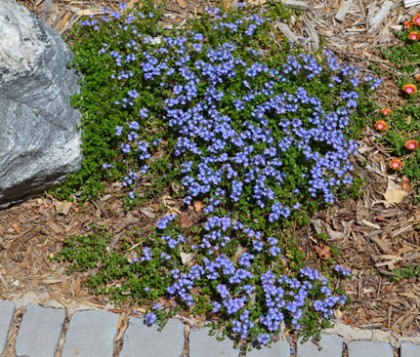
Creeping Veronica
- Sweet Woodruff – Gallium odoratum No dry shade garden should be without this fabulous groundcover. If you have a dry shady spot under a tree, this is the plant for you. It is said that sweet woodruff is one of the few plants that will flourish under the shady canopy of evergreen trees. Small bright green leaves become decorated with tiny white flowers in late spring.
- Orange Carpet Hummingbird Flower – Epilobium canum garrettii If hummingbirds pass through your area consider this California native. It provides a stunning orange floral display in late summer that hummingbirds love, and is ideal to let cascade down a rock wall.
- Blanketflower – Gaillardia aristata Related to sunflowers, this is another North American native that is a great addition to the low-water garden. It blooms from June to September with flower petals that transition from yellow to orange to red. Many cultivars available. Easy to start from seed.
- Silvery Horehound – Marrubium rotundifolium This native of Turkey is a great xeriscape ground cover. It grows 2-4” high and 2-3’ wide. Soft white hairs on the round leaf margins add an effulgent look to the plant.
- Hens and Chicks – Sempervivum spp. This familiar garden succulent from Europe is a hardy performer that will grow just about anywhere. Great for the small spots between other low perennials or rock gardens in full sun. Another nice benefit is how easy it is to transplant the offshoots they provide. Several types are available, with some covered in charming white hairs.
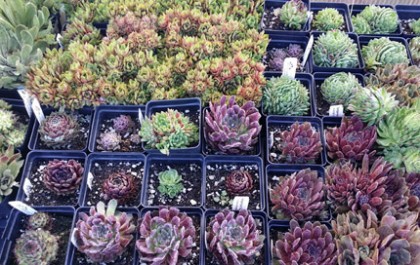
Variety of Sempervivum, a.k.a. Hens and Chicks
- Sunrose – Helianthemum This hardy low-growing perennial provides a delightful floral display starting in June. The profuse blooms hover over a thick mass of low branches that carry small, oval shaped leaves. The flower color is available in shades of red, orange, yellow, pink and white. Perfect for a rock garden or a hot and sunny border area.
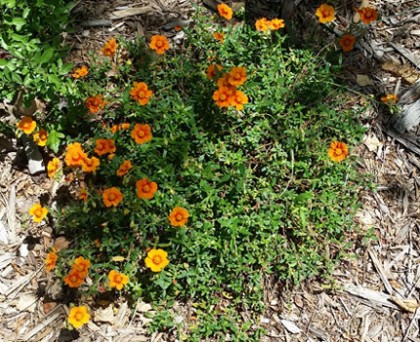
Orange Sunrose
Grasses:
- Blonde Ambition – Bouteloua gracilis ‘Blonde Ambition’ This is a wonderful medium sized grass, 30-36” high and 30-36” wide. It provides multiple seasons of interest, showcasing the classic blue grama grass curled seed heads well into winter.
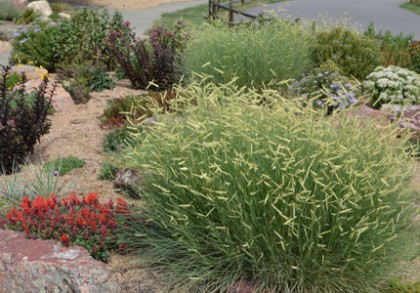
‘Blonde Ambition’ Blue Grama Grass
- ‘Undaunted’ Ruby Muhly – Muhlenbergia reverchonii A 2014 Plant Select introduction. Discovered by Lauren and Scott Ogden, it hails from Oklahoma and Texas. The inflorescence (aka flower cluster) is composed of clouds of tiny pinkish flowers, creating a pink glow with back lighting.
Shrubs:
- Currant – Ribes spp. Currants are medium sized shrubs that grow well in sun, and some species also grow well in filtered shade. This is a notable fact, as many shrubs that do well in part shade require more water than the currants do. Some species provide edible fruit, and some have fragrant flowers. The most notable fragrant currant is Crandall Clove Currant, whose flowers do indeed smell like cloves.
- Dwarf Russian Almond – Prunus tenella Native to Eurasia, this flowering shrub is said to be hardy to zone 2!!! Abundant with pink flowers in the spring, one disadvantage of this shrub is the aggressive suckering habit which may make it hard to control, but this also makes it an attractive cover for wildlife. Size is 3-5’ x 3-5’.
- Dwarf Pinyon Pine – Pinus edulis This slow growing selection of pinyon pine was introduced by Plant Select in 2014. Grows 20-30” height by 20-30” width in 10 years.
- Mohican Viburnum – Viburnum lantana ‘Mohican’ Another great low water shrub that does well in either full or part sun, this viburnum grows 6’ by 6’. White flowers in spring precede orange to red fruits that darken to black in fall.
- Mountain Mahogany – Cercocarpus spp. This western native is indispensable if you’re planning on creating a large native style landscape. Some species are semi-evergreen and one species Cercocarpus montanus the leaves turn a nice russet color in fall. Seeds provide a charming fuzzy appearance that looks great when backlit.
- Peashrub – Caragana spp. A tough shrub from Siberia and China, the peas shrub is, just as the name indicates, related to peas. It produces edible (but not palatable) pods and edible yellow flowers that interest to salads. There are several different species and cultivars to choose from, which range in size from medium to large.
Trees
- Bigtooth Maple – Acer grandidentatum Native to the inter-mountain West, and closely related to the sugar maple. Often growing as multi-stem, it likes full sun to partial shade and low to medium water. The samaras, or winged seeds turn rose color in late summer, and the fall foliage ranges from yellow to red. Grows 20-30’ high by 20-30’ wide.
- Desert Willow – Chilopsis linearis Another typically multi-stem small tree, it is hardy to zone 7 (0 to 5 deg F), but usually survives Denver winters, dying back to the ground each winter, and quickly sprouting new growth each summer. If given a sheltered spot, it may not die back to the ground. Distinctive pink to burgundy flowers with yellow throats. Drought tolerant, with watering being deep and infrequent. Grows 6-30’ high by 6-30’.
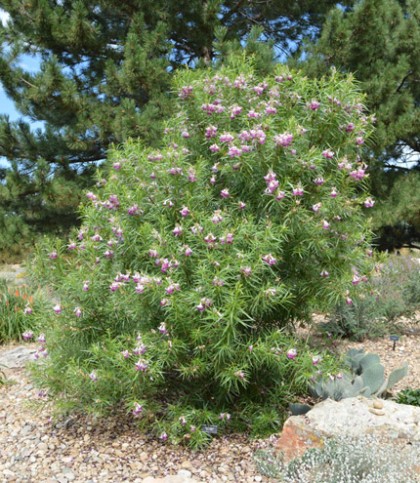
Desert Willow
- Hawthorn – Crataegus spp. These flowering trees are cousins of roses, and bloom in spring with clusters of white flowers that produce long lasting red fruits that offer winter interest. Several species and cultivars have thorns on the branches. Grows 15-25’ high by 15-25’ wide, depending on species and cultivar.
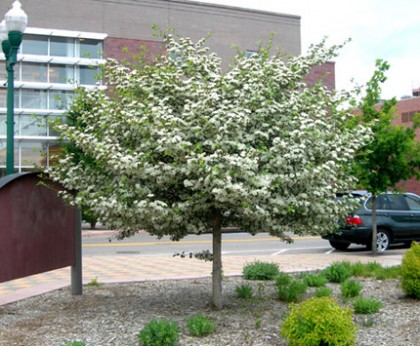
Hawthorn
The Criteria for this List:
– This list is for the Front Range of Colorado. We are somewhere in the middle of zone 4 to 5 on the USDA Plant Hardiness Zone Map.
– I have only included plants that are very easy to care for, and have excluded plants that require a lot of water since that is a key component of Xeriscape. The “best” plants, in my opinion, are those that are well adapted to the local climate and do not require much additional water and maintenance. Of course there are occasions where the use of higher water-use plants is desirable, such as in drainage areas, however I have left them off of this particular list.
This is the official blog of Outdoor Design Group, Colorado Landscape Architects. For more information about our business and our services, click here.
Related Posts:










